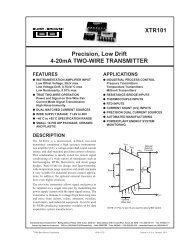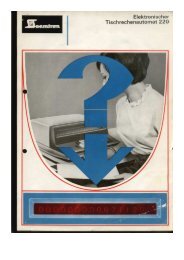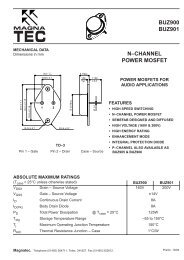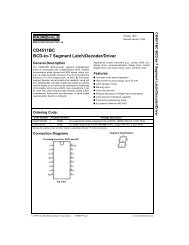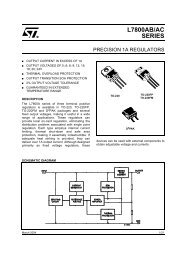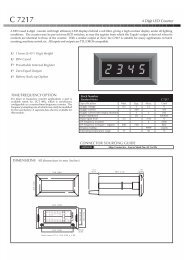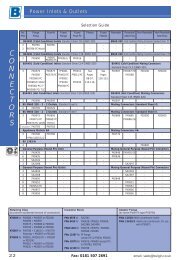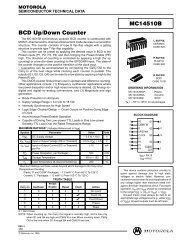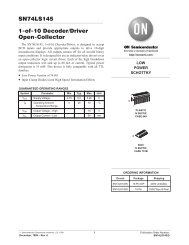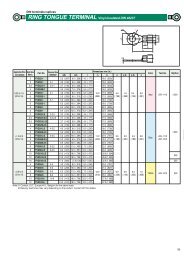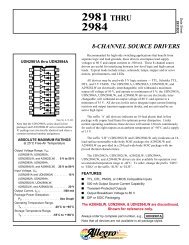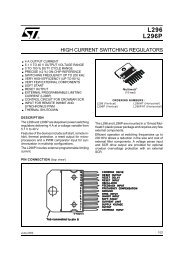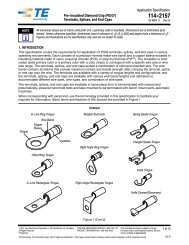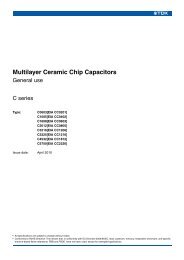OP37 Low Noise, Precision, High Speed Operational Amplifier ...
OP37 Low Noise, Precision, High Speed Operational Amplifier ...
OP37 Low Noise, Precision, High Speed Operational Amplifier ...
You also want an ePaper? Increase the reach of your titles
YUMPU automatically turns print PDFs into web optimized ePapers that Google loves.
a<br />
FEATURES<br />
<strong>Low</strong> <strong>Noise</strong>, 80 nV p-p (0.1 Hz to 10 Hz)<br />
3 nV/÷Hz @ 1 kHz<br />
<strong>Low</strong> Drift, 0.2 V/C<br />
<strong>High</strong> <strong>Speed</strong>, 17 V/s Slew Rate<br />
63 MHz Gain Bandwidth<br />
<strong>Low</strong> Input Offset Voltage, 10 V<br />
Excellent CMRR, 126 dB (Common-Voltage @ 11 V)<br />
<strong>High</strong> Open-Loop Gain, 1.8 Million<br />
Replaces 725, OP-07, SE5534 In Gains > 5<br />
Available in Die Form<br />
GENERAL DESCRIPTION<br />
The <strong>OP37</strong> provides the same high performance as the OP27,<br />
but the design is optimized for circuits with gains greater than<br />
five. This design change increases slew rate to 17 V/ms and<br />
gain-bandwidth product to 63 MHz.<br />
The <strong>OP37</strong> provides the low offset and drift of the OP07<br />
plus higher speed and lower noise. Offsets down to 25 mV and<br />
a maximum drift of 0.6 mV/∞C make the <strong>OP37</strong> ideal for precision<br />
instrumentation applications. Exceptionally low noise<br />
(e n = 3.5 nV/ @ 10 Hz), a low 1/f noise corner frequency of<br />
2.7 Hz, and the high gain of 1.8 million, allow accurate<br />
high-gain amplification of low-level signals.<br />
The low input bias current of 10 nA and offset current of 7 nA<br />
are achieved by using a bias-current cancellation circuit. Over<br />
the military temperature range this typically holds I B and I OS<br />
to 20 nA and 15 nA respectively.<br />
<strong>Low</strong> <strong>Noise</strong>, <strong>Precision</strong>, <strong>High</strong> <strong>Speed</strong><br />
<strong>Operational</strong> <strong>Amplifier</strong> (A VCL > 5)<br />
<strong>OP37</strong><br />
The output stage has good load driving capability. A guaranteed<br />
swing of 10 V into 600 W and low output distortion make the<br />
<strong>OP37</strong> an excellent choice for professional audio applications.<br />
PSRR and CMRR exceed 120 dB. These characteristics, coupled<br />
with long-term drift of 0.2 mV/month, allow the circuit designer<br />
to achieve performance levels previously attained only by<br />
discrete designs.<br />
<strong>Low</strong>-cost, high-volume production of the <strong>OP37</strong> is achieved by<br />
using on-chip zener-zap trimming. This reliable and stable offset<br />
trimming scheme has proved its effectiveness over many years of<br />
production history.<br />
The <strong>OP37</strong> brings low-noise instrumentation-type performance to<br />
such diverse applications as microphone, tapehead, and RIAA<br />
phono preamplifiers, high-speed signal conditioning for data<br />
acquisition systems, and wide-bandwidth instrumentation.<br />
PIN CONNECTIONS<br />
8-Lead Hermetic DIP<br />
(Z Suffix)<br />
Epoxy Mini-DIP<br />
(P Suffix)<br />
8-Lead SO<br />
(S Suffix)<br />
V OS TRIM 1<br />
–IN 2<br />
+IN 3<br />
V– 4<br />
<strong>OP37</strong><br />
8 V OS TRIM<br />
7 V+<br />
6 OUT<br />
5 NC<br />
NC = NO CONNECT<br />
SIMPLIFIED SCHEMATIC<br />
V+<br />
Q6<br />
R3<br />
R1*<br />
1 8<br />
V OS ADJ.<br />
R4<br />
R2*<br />
Q21<br />
C2<br />
R23<br />
R24<br />
Q22<br />
C1<br />
Q46<br />
Q23<br />
Q24<br />
R9<br />
Q20<br />
Q19<br />
NON-INVERTING<br />
INPUT (+)<br />
INVERTING<br />
INPUT (–)<br />
Q3<br />
Q1A<br />
Q1B<br />
Q2B<br />
Q2A<br />
Q11<br />
Q12<br />
Q27<br />
R5<br />
Q28<br />
C3<br />
R12<br />
C4<br />
Q26<br />
Q45<br />
OUTPUT<br />
* R1 AND R2 ARE PERMANENTLY<br />
ADJUSTED AT WAFER TEST FOR<br />
MINIMUM OFFSET VOLTAGE.<br />
REV. B<br />
Information furnished by Analog Devices is believed to be accurate and<br />
reliable. However, no responsibility is assumed by Analog Devices for its<br />
use, nor for any infringements of patents or other rights of third parties that<br />
may result from its use. No license is granted by implication or otherwise<br />
under any patent or patent rights of Analog Devices.<br />
V–<br />
One Technology Way, P.O. Box 9106, Norwood, MA 02062-9106, U.S.A.<br />
Tel: 781/329-4700<br />
www.analog.com<br />
Fax: 781/326-8703 © Analog Devices, Inc., 2002
<strong>OP37</strong><br />
ABSOLUTE MAXIMUM RATINGS 4<br />
Supply Voltage . . . . . . . . . . . . . . . . . . . . . . . . . . . . . . . . . . 22 V<br />
Internal Voltage (Note 1 ) . . . . . . . . . . . . . . . . . . . . . . . . . 22 V<br />
Output Short-Circuit Duration . . . . . . . . . . . . . . . . . Indefinite<br />
Differential Input Voltage (Note2) . . . . . . . . . . . . . . . . . 0.7 V<br />
Differential Input Current (Note 2) . . . . . . . . . . . . . . . . 25 mA<br />
Storage Temperature Range . . . . . . . . . . . . . –65∞C to +150∞C<br />
Operating Temperature Range<br />
<strong>OP37</strong>A . . . . . . . . . . . . . . . . . . . . . . . . . . . . –55∞C to +125∞C<br />
<strong>OP37</strong>E (Z) . . . . . . . . . . . . . . . . . . . . . . . . . . –25∞C to +85∞C<br />
<strong>OP37</strong>E, OP-37F (P) . . . . . . . . . . . . . . . . . . . . . 0∞C to 70∞C<br />
<strong>OP37</strong>G (P, S, Z) . . . . . . . . . . . . . . . . . . . . . –40∞C to +85∞C<br />
Lead Temperature Range (Soldering, 60 sec) . . . . . . . . 300∞C<br />
Junction Temperature . . . . . . . . . . . . . . . . . . –45∞C to +150∞C<br />
3<br />
Package Type JA JC Unit<br />
8-Lead Hermetic DIP (Z) 148 16 ∞C/W<br />
8-Lead Plastic DIP (P) 103 43 ∞C/W<br />
8-Lead SO (S) 158 43 ∞C/W<br />
NOTES<br />
1 For supply voltages less than 22 V, the absolute maximum input voltage is equal<br />
to the supply voltage.<br />
2 The <strong>OP37</strong>’s inputs are protected by back-to-back diodes. Current limiting resistors<br />
are not used in order to achieve low noise. If differential input voltage exceeds 0.7 V,<br />
the input Current should be limited to 25 mA.<br />
3 JA is specified for worst case mounting conditions, i.e., JA is specified for device<br />
in socket for TO, CerDIP, P-DIP, and LCC packages; JA is specified for device<br />
soldered to printed circuit board for SO package.<br />
4 Absolute maximum ratings apply to both DICE and packaged parts, unless<br />
otherwise noted.<br />
ORDERING GUIDE<br />
T A = 25∞C<br />
Operating<br />
V OS MAX CerDIP Plastic Temperature<br />
(V) 8-Lead 8-Lead Range<br />
25 <strong>OP37</strong>AZ* MIL<br />
25 <strong>OP37</strong>EZ <strong>OP37</strong>EP IND/COM<br />
60 <strong>OP37</strong>FP* IND/COM<br />
100 <strong>OP37</strong>GP XIND<br />
100 <strong>OP37</strong>GZ <strong>OP37</strong>GS XIND<br />
*Not for new design, obsolete, April 2002.<br />
CAUTION<br />
ESD (electrostatic discharge) sensitive device. Electrostatic charges as high as 4000 V readily<br />
accumulate on the human body and test equipment and can discharge without detection. Although<br />
the <strong>OP37</strong> features proprietary ESD protection circuitry, permanent damage may occur on<br />
devices subjected to high-energy electrostatic discharges. Therefore, proper ESD precautions<br />
are recommended to avoid performance degradation or loss of functionality.<br />
WARNING!<br />
ESD SENSITIVE DEVICE<br />
–2–<br />
REV. B
SPECIFICATIONS ( V S = 15 V, T A = 25C, unless otherwise noted.)<br />
<strong>OP37</strong>A/E <strong>OP37</strong>F <strong>OP37</strong>G<br />
Parameter Symbol Conditions Min Typ Max Min Typ Max Min Typ Max Unit<br />
Input Offset<br />
Voltage V OS Note 1 10 25 20 60 30 100 mV<br />
Long-Term<br />
Stability V OS /Time Notes 2, 3 0.2 1.0 0.3 1.5 0.4 2.0 mV/Mo<br />
Input Offset<br />
Current I OS 7 35 9 50 12 75 nA<br />
Input Bias<br />
Current I B ± 10 ± 40 ± 12 ± 55 ± 15 ± 80 nA<br />
Input <strong>Noise</strong><br />
Voltage e np-p 1 Hz to 10 Hz 3, 5 0.08 0.18 0.08 0.18 0.09 0.25 mV p-p<br />
Input <strong>Noise</strong><br />
Voltage Density e n f O = 10 Hz 3 3.5 5.5 3.5 5.5 3.8 8.0<br />
f O = 30 Hz 3 3.1 4.5 3.1 4.5 3.3 5.6 nV/÷ Hz<br />
f O = 1000 Hz 3 3.0 3.8 3.0 3.8 3.2 4.5<br />
Input <strong>Noise</strong><br />
Current Density i N f O = 10 Hz 3, 6 1.7 4.0 1.7 4.0 1.7<br />
f O = 30 Hz 3, 6 1.0 2.3 1.0 2.3 1.0 pA/÷ Hz<br />
f O = 1000 Hz 3, 6 0.4 0.6 0.4 0.6 0.4 0.6<br />
Input Resistance<br />
Differential<br />
Mode R IN Note 7 1.3 6 0.9 4 5 0.7 4 MW<br />
Input Resistance<br />
Common Mode R INCM 3 2.5 2 GW<br />
Input Voltage<br />
Range IVR ± 11 ± 12.3 ± 11 ± 12.3 ± 11 ± 12.3 V<br />
Common Mode<br />
Rejection Ratio CMRR V CM = ± 11 V 114 126 106 123 100 120 dB<br />
Power Supply<br />
Rejection Ratio PSSR V S = ± 4 V 1 10 1 10 2 20 mV/ V<br />
to ±18 V<br />
Large Signal<br />
Voltage Gain A VO R L ≥ 2 kW,<br />
V O = ± 10 V 1000 1800 1000 1800 700 1500 V/mV<br />
R L ≥ 1 kW,<br />
Vo = ± 10 V 800 1500 800 1500 400 1500 V/mV<br />
R L ≥ 600 W,<br />
V O = ± 1 V,<br />
V S ±4 4 250 700 250 700 200 500 V/mV<br />
Output Voltage<br />
Swing V O R L ≥ 2 kW ±12.0 ± 13.8 ± 12.0 ± 13.8 ± 11.5 ± 13.5 V<br />
R L ≥ 600 W ±10 ± 11.5 ± 10 ± 11.5 ± 10 ± 11.5 V<br />
Slew Rate SR R L ≥ 2k W 4 11 17 11 17 11 17 V/ms<br />
Gain Bandwidth<br />
Product GBW f O = 10 kHz 4 45 63 45 63 45 63 MHz<br />
f O = 1 MHz 40 40 40 MHz<br />
Open-Loop<br />
Output Resistance R O V O = 0, I O = 0 70 70 70 W<br />
Power<br />
Consumption P d V O = 0 90 140 90 140 100 170 mW<br />
Offset Adjustment<br />
Range R P = 10 kW ±4 ± 4 ± 4 mV<br />
REV. B –3–<br />
<strong>OP37</strong><br />
NOTES<br />
1 Input offset voltage measurements are performed by automated test equipment approximately 0.5 seconds after application of power. A/E grades guaranteed fully<br />
warmed up.<br />
2 Long term input offset voltage stability refers to the average trend line of V OS vs. Time over extended periods after the first 30 days of operation. Excluding the initial<br />
hour of operation, changes in V OS during the first 30 days are typically 2.5 mV—refer to typical performance curve.<br />
3 Sample tested.<br />
4 Guaranteed by design.<br />
5 See test circuit and frequency response curve for 0.1 Hz to 10 Hz tester.<br />
6 See test circuit for current noise measurement.<br />
7 Guaranteed by input bias current.
<strong>OP37</strong>–SPECIFICATIONS<br />
Electrical Characteristics<br />
<strong>OP37</strong>A<br />
<strong>OP37</strong>C<br />
Parameter Symbol Conditions Min Typ Max Min Typ Max Unit<br />
Input Offset<br />
Voltage V OS Note 1 10 25 30 100 mV<br />
Average Input<br />
Offset Drift TCV OS Note 2<br />
TCV OSN Note 3 0.2 0.6 0.4 1.8 mV/∞C<br />
Input Offset<br />
Current I OS 15 50 30 135 nA<br />
Input Bias<br />
Current I B ±20 ± 60 ±35 ±150 nA<br />
Input Voltage<br />
Range IVR ±10.3 ±11.5 ±10.2 ±11.5 V<br />
Common Mode<br />
Rejection Ratio CMRR V CM = ± 10 V 108 122 94 116 dB<br />
Power Supply<br />
Rejection Ratio PSRR V S = ±4.5 V to<br />
± 18 V 2 16 4 51 mV/ V<br />
Large-Signal<br />
Voltage Gain A VO R L ≥ 2 kW,<br />
V O = ± 10 V 600 1200 300 800 V/mV<br />
Output Voltage<br />
Swing V O R L ≥ 2 kW ±11.5 ±13.5 ±10.5 ±13.0 V<br />
Electrical Characteristics<br />
( V S = 15 V, –55C < T A < +125C, unless otherwise noted.)<br />
(V S = 15 V, –25C < T A < +85C for <strong>OP37</strong>EZ/FZ, 0C < T A < 70C for <strong>OP37</strong>EP/FP, and –40C < T A<br />
< +85C for <strong>OP37</strong>GP/GS/GZ, unless otherwise noted.)<br />
<strong>OP37</strong>E <strong>OP37</strong>F <strong>OP37</strong>C<br />
Parameter Symbol Conditions Min Typ Max Min Typ Max Min Typ Max Unit<br />
Input Offset<br />
Voltage V OS 20 50 40 140 55 220 mV<br />
Average Input<br />
Offset Drift TCV OS Note 2<br />
TCV OSN Note 3 0.2 0.6 0.3 1.3 0.4 1.8 mV/∞C<br />
Input Offset<br />
Current I OS 10 50 14 85 20 135 nA<br />
Input Bias<br />
Current I B ±14 ±60 ±18 ±95 ±25 ±150 nA<br />
Input Voltage<br />
Range IVR ±10.5 ±11.8 ±10.5 ±11.8 ±10.5 ±11.8 V<br />
Common Mode<br />
Rejection Ratio CMRR V CM = ±10 V 108 122 100 119 94 116 dB<br />
Power Supply<br />
Rejection Ratio PSRR V S = ± 4.5 V to<br />
±18 V 2 15 2 16 4 32 mV/ V<br />
Large-Signal<br />
Voltage Gain A VO R L ≥ 2 kW,<br />
VO = ±10 V 750 1500 700 1300 450 1000 V/mV<br />
Output Voltage<br />
Swing V O R L ≥ 2 kW ±11.7 ±13.6 ±11.4 ±13.5 ±11 ±13.3 V<br />
NOTES<br />
1 Input offset voltage measurements are performed by automated test equipment approximately 0.5 seconds after application of power. A/E grades guaranteed fully<br />
warmed up.<br />
2 The TC VOS performance is within the specifications unnulled or when nulled withR P = 8 kW to 20 kW. TC VOS is 100% tested for A/E grades, sample tested for F/G grades.<br />
3 Guaranteed by design.<br />
–4–<br />
REV. B
<strong>OP37</strong><br />
BINDING DIAGRAM<br />
1<br />
1990<br />
1427U<br />
8<br />
1. NULL<br />
2. (–) INPUT<br />
3. (+) INPUT<br />
4. V–<br />
6. OUTPUT<br />
7. V+<br />
8. NULL<br />
2<br />
3<br />
7<br />
Wafer Test Limits<br />
<strong>OP37</strong>NT <strong>OP37</strong>N <strong>OP37</strong>GT <strong>OP37</strong>G <strong>OP37</strong>GR<br />
Parameter Symbol Conditions Limit Limit Limit Limit Limit Unit<br />
Input Offset<br />
Voltage V OS Note 1 60 35 200 60 100 mV MAX<br />
Input Offset<br />
Current I OS 50 35 85 50 75 nA MAX<br />
Input Bias<br />
Current I B ± 60 ± 40 ± 95 ± 55 ± 80 nA MAX<br />
Input Voltage<br />
Range IVR ± 10.3 ± 11 ± 10.3 ± 11 ± 11 V MIN<br />
Common Mode<br />
Rejection Ratio CMRR V CM = ± 11 V 108 114 100 106 100 dB MIN<br />
Power Supply<br />
Rejection Ratio PSRR T A = 25∞C,<br />
V S = ±4 V to<br />
± 18 V 10 10 10 10 20 mV/V MAX<br />
T A = 125∞C,<br />
V S = ±4.5 V to<br />
± 18 V 16 20 mV/V MAX<br />
Large-Signal<br />
Voltage Gain A VO R L ≥ 2 kW,<br />
V O = ±10 V 600 1000 500 1000 700 V/mV MIN<br />
R L ≥ 1 kW,<br />
V O = ±10 V 800 800 V/mV MIN<br />
Output Voltage<br />
Swing V O R L ≥ 2 kW ±11.5 ± 12 ± 11 ± 12 ± 11.5 V MIN<br />
R L ≥ 600 kW ±10 ± 10 ± 10 V MIN<br />
Power<br />
Consumption P d V O = 0 140 140 170 mW MAX<br />
NOTES<br />
For 25∞C characterlstics of <strong>OP37</strong>NT and <strong>OP37</strong>GT devices, see <strong>OP37</strong>N and <strong>OP37</strong>G characteristics, respectively.<br />
Electrical tests are performed at wafer probe to the limits shown. Due to variations in assembly methods and normal yield loss, yield after packaging is not guaranteed<br />
for standard product dice. Consult factory to negotiate specifications based on dice lot qualification through sample lot assembly and testing.<br />
REV. B<br />
4 6<br />
(V S = 15 V, T A = 25C for <strong>OP37</strong>N, <strong>OP37</strong>G, and <strong>OP37</strong>GR devices; T A = 125C for <strong>OP37</strong>NT and <strong>OP37</strong>GT devices,<br />
unless otherwise noted.)<br />
–5–
<strong>OP37</strong><br />
Typical Electrical Characteristics<br />
<strong>OP37</strong>NT <strong>OP37</strong>N <strong>OP37</strong>GT <strong>OP37</strong>G <strong>OP37</strong>GR<br />
Parameter Symbol Conditions Typical Typical Typical Typical Typical Unit<br />
Average Input<br />
Offset Voltage<br />
Drift TCV OS or Nulled or<br />
(V S = 15 V, T A = 25C, unless otherwise noted.)<br />
TCV OSN Unnulled<br />
R P = 8 kW<br />
to 20 kW 0.2 0.2 0.3 0.3 0.4 mV/∞C<br />
Average Input<br />
Offset Current<br />
Drift TCI OS 80 80 130 130 180 pA/∞C<br />
Average Input<br />
Bias Current<br />
Drift TCI B 100 100 160 160 200 pA/∞C<br />
Input <strong>Noise</strong><br />
Voltage Density e n f O = 10 Hz 3.5 3.5 3.5 3.5 3.8 nV/÷Hz<br />
f O = 30 Hz 3.1 3.1 3.1 3.1 3.3 nV/÷Hz<br />
f O = 1000 Hz 3.0 3.0 3.0 3.0 3.2 nV/÷Hz<br />
Input <strong>Noise</strong><br />
Current Density i n f O = 10 Hz 1.7 1.7 1.7 1.7 1.7 pA/÷ Hz<br />
f O = 30 Hz 1.0 1.0 1.0 1.0 1.0 pA/÷ Hz<br />
f O = 1000 Hz 0.4 0.4 0.4 0.4 0.4 pA/÷ Hz<br />
Input <strong>Noise</strong><br />
Voltage e n p-p 0.1 Hz to<br />
10 Hz 0.08 0.08 0.08 0.08 0.09 mV p-p<br />
Slew Rate SR R L ≥ 2k W 17 17 17 17 17 V/ms<br />
Gain Bandwidth<br />
Product GBW f O = 10 kHz 63 63 63 63 63 MHz<br />
–6–<br />
REV. B
Typical Performance Characteristics– <strong>OP37</strong><br />
GAIN – dB<br />
100<br />
90<br />
80<br />
70<br />
60<br />
50<br />
40<br />
30<br />
0.01<br />
TEST TIME OF 10sec MUST BE USED<br />
TO LIMIT LOW FREQUENCY<br />
(
<strong>OP37</strong><br />
OFFSET VOLTAGE – V<br />
60<br />
50<br />
40<br />
30<br />
20<br />
10<br />
0<br />
–10<br />
–20<br />
<strong>OP37</strong>C<br />
<strong>OP37</strong>B<br />
<strong>OP37</strong>A<br />
<strong>OP37</strong>B<br />
<strong>OP37</strong>A<br />
<strong>OP37</strong>A<br />
–30<br />
<strong>OP37</strong>B<br />
–40 TRIMMING WITH<br />
–50<br />
10k POT DOES<br />
NOT CHANGE<br />
–60 TCV OS<br />
<strong>OP37</strong>C<br />
–70<br />
–75 –50 –25 0 25 50 75 100 125 150 175<br />
TEMPERATURE – C<br />
TPC 10. Offset Voltage Drift of Eight<br />
Representative Units vs. Temperature<br />
CHANGE IN OFFSET VOLTAGE – V<br />
6<br />
4<br />
2<br />
0<br />
–2<br />
–4<br />
–6<br />
6<br />
4<br />
2<br />
0<br />
–2<br />
–4<br />
–6<br />
0<br />
1 2 3 4 5 6 7<br />
TIME – MONTHS<br />
TPC 11. Long-Term Offset Voltage<br />
Drift of Six Representative Units<br />
CHANGE IN INPUT OFFSET VOLTAGE – V<br />
10<br />
5<br />
T A = 25C<br />
V S = 15V<br />
<strong>OP37</strong>C/G<br />
<strong>OP37</strong>F<br />
<strong>OP37</strong>A/E<br />
1<br />
0 1 2 3 4<br />
TIME AFTER POWER ON – MINUTES<br />
TPC 12. Warm Up Offset Voltage Drift<br />
5<br />
30<br />
V S = +15V<br />
50<br />
V S = +15V<br />
50<br />
V S = 15V<br />
OPEN-LOOP GAIN – dB<br />
25<br />
20<br />
15<br />
10<br />
5<br />
T A =<br />
25C<br />
T A = 70C<br />
THERMAL SHOCK<br />
RESPONSE BAND<br />
DEVICE IMMERSED<br />
IN 70C OIL BATH<br />
INPUT BIAS CURRENT – nA<br />
40<br />
30<br />
20<br />
10<br />
<strong>OP37</strong>B<br />
<strong>OP37</strong>C<br />
<strong>OP37</strong>A<br />
INPUT OFFSET CURRENT – nA<br />
40<br />
30<br />
20<br />
10<br />
<strong>OP37</strong>B<br />
<strong>OP37</strong>C<br />
<strong>OP37</strong>A<br />
0<br />
–20<br />
0 20 40 60 80 100<br />
TIME – Seconds<br />
0<br />
–50<br />
–25 0 25 50 75 100 125 150<br />
TEMPERATURE – C<br />
0<br />
–75<br />
–50 –25 0 25 50 75 100 125<br />
TEMPERATURE – C<br />
TPC 13. Offset Voltage Change Due<br />
to Thermal Shock<br />
TPC 14. Input Bias Current vs. Temperature<br />
TPC 15. Input Offset Current vs.<br />
Temperature<br />
OPEN-LOOP VOLTAGE GAIN – dB<br />
140<br />
120<br />
100<br />
80<br />
60<br />
40<br />
20<br />
0<br />
1<br />
T A = 25C<br />
V S = 15V<br />
R L 2k<br />
10 10 2 10 3 10 4 10 5 10 6 10 7 10 8<br />
FREQUENCY – Hz<br />
TPC 16. Open-Loop Gain vs. Frequency<br />
PHASE MARGIN – DEG<br />
SLEW RATE – V/s<br />
80<br />
75<br />
70<br />
65<br />
60<br />
55<br />
30<br />
25<br />
20<br />
15<br />
10<br />
–50<br />
M<br />
GBW<br />
SLEW<br />
40<br />
–25 0 25 50 75 100 125<br />
TEMPERATURE – C<br />
V S = 15V<br />
90<br />
85<br />
80<br />
75<br />
70<br />
65<br />
60<br />
55<br />
50<br />
45<br />
TPC 17. Slew Rate, Gain Bandwidth<br />
Product, Phase Margin vs. Temperature<br />
GAIN-BANDWIDTH PRODUCT – MHz<br />
F = 10kHz<br />
GAIN – dB<br />
60<br />
50<br />
40<br />
30<br />
20<br />
10<br />
0<br />
PHASE<br />
MARGIN<br />
= 71<br />
T A = 25C<br />
V S = 15V<br />
A V = 5<br />
–80<br />
–100<br />
–120<br />
–140<br />
–160<br />
–180<br />
–200<br />
–10<br />
–220<br />
100k 1M 10M 100M<br />
FREQUENCY – Hz<br />
TPC 18. Gain, Phase Shift vs. Frequency<br />
PHASE SHIFT – Degrees<br />
–8–<br />
REV. B
<strong>OP37</strong><br />
OPEN-LOOP GAIN – V/V<br />
2.5<br />
2.0<br />
1.5<br />
1.0<br />
0.5<br />
0<br />
T A = 25C<br />
R L = 2k<br />
R L = 1k<br />
0 10 20 30 40<br />
TOTAL SUPPLY VOLTAGE – Volts<br />
TPC 19. Open-Loop Voltage Gain vs.<br />
Supply Voltage<br />
50<br />
PEAK-TO-PEAK AMPLITUDE – Volts<br />
28<br />
24<br />
20<br />
16<br />
12<br />
8<br />
4<br />
T A = 25C<br />
V S = 15V<br />
0<br />
10 4 10 5 10 6 10 7<br />
FREQUENCY – Hz<br />
TPC 20. Maximum Output Swing vs.<br />
Frequency<br />
MAXIMUM OUTPUT – Volts<br />
18<br />
16<br />
14<br />
12<br />
10<br />
8<br />
6<br />
4<br />
2<br />
0<br />
POSITIVE<br />
SWING<br />
NEGATIVE<br />
SWING<br />
T A = 25C<br />
V S = 15V<br />
–2<br />
100 1k 10k<br />
LOAD RESISTANCE – <br />
TPC 21. Maximum Output Voltage<br />
vs. Load Resistance<br />
80<br />
5V 1µs<br />
20mV<br />
200ns<br />
PERCENT OVERSHOOT<br />
60<br />
40<br />
20 V S = 15V<br />
V IN = 20mV<br />
A V = +5 (1k, 250)<br />
+10V<br />
0V<br />
–10V T A = 25C<br />
V S = 15V<br />
A V = +5 (1k, 250)<br />
+50mV<br />
0V<br />
–50mV<br />
T A = 25C<br />
V S = 15V<br />
A V = +5<br />
(1k, 250)<br />
0<br />
0 500 2000<br />
1000 1500<br />
CAPACITIVE LOAD – pF<br />
TPC 22. Small-Signal Overshoot vs.<br />
Capacitive Load<br />
TPC 23. Large-Signal Transient<br />
Response<br />
TPC 24. Small-Signal Transient<br />
Response<br />
SHORT-CIRCUIT CURRENT – mA<br />
60<br />
50<br />
40<br />
30<br />
20<br />
T A = 25C<br />
V S = 15V<br />
I SC (+)<br />
I SC (–)<br />
CMRR – dB<br />
140<br />
120<br />
100<br />
80<br />
60<br />
V S = 15V<br />
T A = 25C<br />
V CM = 10V<br />
COMMON-MODE RANGE – Volts<br />
16<br />
12<br />
8<br />
4<br />
0<br />
–4<br />
–8<br />
–12<br />
T A = –55C<br />
T A = +25C<br />
T A = +125C<br />
T A = –55C<br />
T A = +25C<br />
T A = +125C<br />
10<br />
0 1 2 3 4 5<br />
TIME FROM OUTPUT SHORTED TO<br />
GROUND – MINUTES<br />
40<br />
1k<br />
10k 100k 1M 10M<br />
FREQUENCY – Hz<br />
–16<br />
0 5 10 15 20<br />
SUPPLY VOLTAGE – Volts<br />
TPC 25. Short-Circuit Current vs. Time<br />
TPC 26. CMRR vs. Frequency<br />
TPC 27. Common-Mode Input Range<br />
vs. Supply Voltage<br />
REV. B –9–
<strong>OP37</strong><br />
10<br />
0.1F<br />
100k<br />
<strong>OP37</strong><br />
D.U.T.<br />
VOLTAGE<br />
GAIN<br />
= 50,000<br />
4.7F<br />
2k<br />
OP12<br />
100k<br />
0.1F<br />
24.3k<br />
4.3k<br />
22F<br />
2.2F<br />
SCOPE 1<br />
R IN = 1M<br />
110k<br />
1 SEC/DIV<br />
OPEN-LOOP VOLTAGE GAIN – V/V<br />
2.4<br />
2.2<br />
2.0<br />
1.8<br />
1.6<br />
1.4<br />
1.2<br />
1.0<br />
0.8<br />
0.6<br />
T A = 25C<br />
V S = 15V<br />
0.4<br />
100 1k 10k 100k<br />
LOAD RESISTANCE – <br />
TPC 28. <strong>Noise</strong> Test Circuit (0.1 Hz to<br />
10 Hz)<br />
TPC 29. <strong>Low</strong>-Frequency <strong>Noise</strong><br />
TPC 30. Open-Loop Voltage Gain vs.<br />
Load Resistance<br />
POWER SUPPLY REJECTION RATIO – dB<br />
160<br />
140<br />
120<br />
100<br />
80<br />
60<br />
40<br />
20<br />
0<br />
1<br />
POSITIVE<br />
SWING<br />
NEGATIVE<br />
SWING<br />
T A = 25C<br />
10 100 1k 10k 100k 1M 10M 100M<br />
FREQUENCY – Hz<br />
TPC 31. PSRR vs. Frequency<br />
SLEW RATE – V/V<br />
19<br />
18<br />
17<br />
16<br />
T A = 25C<br />
V S = 15V<br />
A V = 5<br />
V O = 20V p-p<br />
15<br />
100 1k 10k 100k<br />
LOAD RESISTANCE – <br />
TPC 32. Slew Rate vs. Load<br />
VOLTAGE NOISE – V/s<br />
20<br />
15<br />
10<br />
5<br />
0<br />
3<br />
T A = 25C<br />
A VCL = 5<br />
RISE<br />
FALL<br />
6 9 12 15 18 21<br />
SUPPLY VOLTAGE – Volts<br />
TPC 33. Slew Rate vs. Supply Voltage<br />
–10–<br />
REV. B
<strong>OP37</strong><br />
APPLICATIONS INFORMATION<br />
<strong>OP37</strong> Series units may be inserted directly into 725 and OP07<br />
sockets with or without removal of external compensation or<br />
nulling components. Additionally, the <strong>OP37</strong> may be fitted to<br />
unnulled 741type sockets; however, if conventional 741 nulling<br />
circuitry is in use, it should be modified or removed to ensure<br />
correct <strong>OP37</strong> operation. <strong>OP37</strong> offset voltage may be nulled to<br />
zero (or other desired setting) using a potentiometer (see figure 1).<br />
The <strong>OP37</strong> provides stable operation with load capacitances of<br />
up to 1000 pF and ±10 V swings; larger capacitances should be<br />
decoupled with a 50 W resistor inside the feedback loop. Closed<br />
loop gain must be at least five. For closed loop gain between five<br />
to ten, the designer should consider both the OP27 and the <strong>OP37</strong>.<br />
For gains above ten, the <strong>OP37</strong> has a clear advantage over the<br />
unity stable OP27.<br />
Thermoelectric voltages generated by dissimilar metals at the input<br />
terminal contacts can degrade the drift performance. Best<br />
operation will be obtained when both input contacts are maintained<br />
at the same temperature.<br />
–<br />
+<br />
<strong>OP37</strong><br />
V–<br />
10k R P<br />
V+<br />
OUTPUT<br />
Figure 1. Offset Nulling Circuit<br />
Offset Voltage Adjustment<br />
The input offset voltage of the <strong>OP37</strong> is trimmed at wafer level.<br />
However, if further adjustment of V OS is necessary, a 10 kW trim<br />
potentiometer may be used. TCV OS is not degraded (see offset<br />
nulling circuit). Other potentiometer values from 1 kW to 1 MW<br />
can be used with a slight degradation (0.1 mV/∞C to 0.2 mV/∞C) of<br />
TCV OS . Trimming to a value other than zero creates a drift of<br />
approximately (V OS /300) mV/∞C. For example, the change in TCV OS<br />
will be 0.33 mV/∞C if V OS is adjusted to 100 mV. The offset voltage<br />
adjustment range with a 10 kW potentiometer is ±4 mV. If smaller<br />
adjustment range is required, the nulling sensitivity can be reduced<br />
by using a smaller pot in conjunction with fixed resistors. For<br />
example, the network shown in figure 2 will have a ± 280 mV adjustment<br />
range.<br />
1 4.7k 1k POT 4.7k 8<br />
<strong>Noise</strong> Measurements<br />
To measure the 80 nV peak-to-peak noise specification of the<br />
<strong>OP37</strong> in the 0.1 Hz to 10 Hz range, the following precautions<br />
must be observed:<br />
∑ The device has to be warmed-up for at least five minutes. As<br />
shown in the warm-up drift curve, the offset voltage typically<br />
changes 4 mV due to increasing chip temperature after power up.<br />
In the ten second measurement interval, these temperatureinduced<br />
effects can exceed tens of nanovolts.<br />
∑ For similar reasons, the device has to be well-shielded from<br />
air currents. Shielding minimizes thermocouple effects.<br />
∑ Sudden motion in the vicinity of the device can also<br />
“feedthrough” to increase the observed noise.<br />
∑ The test time to measure 0.1 Hz to l0 Hz noise should not<br />
exceed 10 seconds. As shown in the noise-tester frequency<br />
response curve, the 0.1 Hz corner is defined by only one zero.<br />
The test time of ten seconds acts as an additional zero to eliminate<br />
noise contributions from the frequency band below 0.1 Hz.<br />
∑ A noise-voltage-density test is recommended when measuring<br />
noise on a large number of units. A 10 Hz noise-voltage-density<br />
measurement will correlate well with a 0.1 Hz-to-10 Hz peak-to-peak<br />
noise reading, since both results are determined by the white<br />
noise and the location of the 1/f corner frequency.<br />
Optimizing Linearity<br />
Best linearity will be obtained by designing for the minimum<br />
output current required for the application. <strong>High</strong> gain and<br />
excellent linearity can be achieved by operating the op amp with<br />
a peak output current of less than ± 10 mA.<br />
Instrumentation <strong>Amplifier</strong><br />
A three-op-amp instrumentation amplifier, shown in figure 4,<br />
provides high gain and wide bandwidth. The input noise of the<br />
circuit below is 4.9 nV/÷Hz. The gain of the input stage is set at<br />
25 and the gain of the second stage is 40; overall gain is 1000.<br />
The amplifier bandwidth of 800 kHz is extraordinarily good for<br />
a precision instrumentation amplifier. Set to a gain of 1000, this<br />
yields a gain bandwidth product of 800 MHz. The full-power<br />
bandwidth for a 20 V p-p output is 250 kHz. Potentiometer<br />
R7 provides quadrature trimming to optimize the instrumentation<br />
amplifier’s ac common-mode rejection.<br />
INPUT (–)<br />
+<br />
– <strong>OP37</strong><br />
R1<br />
5k<br />
0.1%<br />
R5<br />
500<br />
0.1%<br />
R8<br />
20k<br />
0.1%<br />
V+<br />
Figure 2. Offset Voltage Adjustment<br />
R3<br />
390<br />
R2<br />
100<br />
R4<br />
5k<br />
0.1%<br />
C1<br />
100pF<br />
R7<br />
100k<br />
–<br />
<strong>OP37</strong><br />
+<br />
V OUT<br />
+18V<br />
<strong>OP37</strong><br />
–18V<br />
Figure 3. Burn-In Circuit<br />
INPUT (+)<br />
–<br />
<strong>OP37</strong><br />
+<br />
R6<br />
500<br />
0.1%<br />
R9<br />
19.8k<br />
R10<br />
500<br />
NOTES:<br />
TRIM R2 FOR A VCL = 1000<br />
TRIM R10 FOR dc CMRR<br />
TRIM R7 FOR MINIMUM V OUT AT V CM = 20V p-p, 10kHz<br />
Figure 4a. Instrumentation <strong>Amplifier</strong><br />
REV. B<br />
–11–
<strong>OP37</strong><br />
CMRR – dB<br />
140<br />
120<br />
100<br />
80<br />
60<br />
R S = 0<br />
R S = 100,<br />
1k UNBALANCED<br />
T A = 25C<br />
V S = 15V<br />
V CM = 20V p-p<br />
AC TRIM @ 10kHz<br />
R S = 0<br />
R S = 1k<br />
BALANCED<br />
p-p NOISE – nV<br />
1k<br />
500<br />
100<br />
50<br />
OP08/108<br />
5534<br />
OP07<br />
OP27/37<br />
1<br />
2<br />
1 R S UNMATCHED<br />
e.g. R S = R S1 = 10k, R S2 = 0<br />
2 R S MATCHED<br />
e.g. R S = 10k, R S1 = R S2 = 5k<br />
RS1<br />
40<br />
10<br />
100 1k 10k 100k 1M<br />
FREQUENCY – Hz<br />
Figure 4b. CMRR vs. Frequency<br />
Comments on <strong>Noise</strong><br />
The <strong>OP37</strong> is a very low-noise monolithic op amp. The outstanding<br />
input voltage noise characteristics of the <strong>OP37</strong> are achieved<br />
mainly by operating the input stage at a high quiescent current.<br />
The input bias and offset currents, which would normally increase,<br />
are held to reasonable values by the input bias current cancellation<br />
circuit. The <strong>OP37</strong>A/E has I B and I OS of only ± 40 nA and 35 nA<br />
respectively at 25∞C. This is particularly important when the input<br />
has a high source resistance. In addition, many audio amplifier<br />
designers prefer to use direct coupling. The high I B . TCV OS of<br />
previous designs have made direct coupling difficult, if not<br />
impossible, to use.<br />
TOTAL NOISE – nV/ Hz<br />
100<br />
50<br />
10<br />
5<br />
OP08/108<br />
OP07<br />
5534<br />
OP27/37<br />
1 R S UNMATCHED<br />
e.g. R S = R S1 = 10k, R S2 = 0<br />
2 R S MATCHED<br />
e.g. R S = 10k, R S1 = R S2 = 5k<br />
R S1<br />
REGISTER<br />
NOISE ONLY<br />
1<br />
50 100 500 1k 5k 10k<br />
50k<br />
R S – SOURCE RESISTANCE – <br />
Figure 5. <strong>Noise</strong> vs. Resistance (Including Resistor <strong>Noise</strong><br />
@ 1000 Hz)<br />
Voltage noise is inversely proportional to the square-root of bias<br />
current, but current noise is proportional to the square-root of<br />
bias current. The <strong>OP37</strong>’s noise advantage disappears when high<br />
source-resistors are used. Figures 5, 6, and 7 compare OP-37<br />
observed total noise with the noise performance of other devices<br />
in different circuit applications.<br />
Total noise = [( Voltage noise)2 + (current noise RS)2 +<br />
(resistor noise_]1/2<br />
Figure 5 shows noise versus source resistance at 1000 Hz. The<br />
same plot applies to wideband noise. To use this plot, just multiply<br />
the vertical scale by the square-root of the bandwidth.<br />
R S2<br />
1<br />
2<br />
REGISTER<br />
RS2<br />
NOISE ONLY<br />
10<br />
50 100 500 1k 5k 10k<br />
50k<br />
R S – SOURCE RESISTANCE – <br />
Figure 6. Peak-to-Peak <strong>Noise</strong> (0.1 Hz to 10 Hz) vs. Source<br />
Resistance (Includes Resistor <strong>Noise</strong>)<br />
At R S < 1 kW key the <strong>OP37</strong>’s low voltage noise is maintained.<br />
With R S < 1 kW, total noise increases, but is dominated by the<br />
resistor noise rather than current or voltage noise. It is only<br />
beyond Rs of 20 kW that current noise starts to dominate. The<br />
argument can be made that current noise is not important for<br />
applications with low to-moderate source resistances. The<br />
crossover between the <strong>OP37</strong> and OP07 and OP08 noise occurs<br />
in the 15 kW to 40 kW region.<br />
TOTAL NOISE – nV/ Hz<br />
100<br />
50<br />
10<br />
5<br />
OP08/108<br />
OP07<br />
5534<br />
OP27/37<br />
1 R S UNMATCHED<br />
e.g. R S = R S1 = 10k, R S2 = 0<br />
2 R S MATCHED<br />
e.g. R S = 10k, R S1 = R S2 = 5k<br />
RS1<br />
REGISTER<br />
RS2<br />
NOISE ONLY<br />
1<br />
50 100 500 1k 5k 10k<br />
50k<br />
R S – SOURCE RESISTANCE – <br />
Figure 7. <strong>Noise</strong> vs. Source resistance (Includes Resistor<br />
<strong>Noise</strong> @ 10 Hz)<br />
Figure 6 shows the 0.1 Hz to 10 Hz peak-to-peak noise. Here<br />
the picture is less favorable; resistor noise is negligible, current<br />
noise becomes important because it is inversely proportional to<br />
the square-root of frequency. The crossover with the OP07<br />
occurs in the 3 kW to 5 kW range depending on whether balanced<br />
or unbalanced source resistors are used (at 3 kW the I B .<br />
I OS error also can be three times the V OS spec.).<br />
Therefore, for low-frequency applications, the OP07 is better<br />
than the OP27/37 when Rs > 3 kW. The only exception is when<br />
gain error is important. Figure 7 illustrates the 10 Hz noise. As<br />
expected, the results are between the previous two figures.<br />
For reference, typical source resistances of some signal sources<br />
are listed in Table I.<br />
1<br />
2<br />
–12–<br />
REV. B
<strong>OP37</strong><br />
Table I.<br />
Source<br />
Device Impedance Comments<br />
Straln Gauge
<strong>OP37</strong><br />
<strong>OP37</strong> are free of bias-current transients upon power up or power<br />
down. However, it is always advantageous to control the speed<br />
of power supply rise and fall, to eliminate transients.<br />
In addition, the dc resistance of the head should be carefully<br />
controlled, and preferably below 1 kW. For this configuration,<br />
the bias-current induced offset voltage can be greater than the<br />
170 pV maximum offset if the head resistance is not sufficiently<br />
controlled.<br />
A simple, but effective, fixed-gain transformerless microphone<br />
preamp (Figure 10) amplifies differential signals from low impedance<br />
microphones by 50 dB, and has an input impedance of 2 kW.<br />
Because of the high working gain of the circuit, an <strong>OP37</strong> helps<br />
to preserve bandwidth, which will be 110 kHz. As the <strong>OP37</strong> is a<br />
decompensated device (minimum stable gain of 5), a dummy<br />
resistor, R P , may be necessary, if the microphone is to be<br />
unplugged. Otherwise the 100% feedback from the open input<br />
may cause the amplifier to oscillate.<br />
LOW IMPEDANCE<br />
MICROPHONE INPUT<br />
(Z = 50 TO 200 )<br />
R3<br />
=<br />
R4<br />
R1 R2<br />
R1<br />
1k<br />
R2<br />
1k<br />
Rp<br />
30k<br />
R3<br />
316k<br />
–<br />
<strong>OP37</strong><br />
+<br />
R4<br />
316k<br />
C1<br />
5F<br />
R6<br />
100<br />
R7<br />
10k<br />
OUTPUT<br />
Figure 10. Fixed Gain Transformerless Microphone<br />
Preamp<br />
Common-mode input-noise rejection will depend upon the match<br />
of the bridge-resistor ratios. Either close-tolerance (0.1%) types<br />
should be used, or R4 should be trimmed for best CMRR. All<br />
resistors should be metal-film types for best stability and low noise.<br />
<strong>Noise</strong> performance of this circuit is limited more by the input<br />
resistors R1 and R2 than by the op amp, as R1 and R2 each<br />
generate a 4 nV/÷Hz noise, while the op amp generates a 3.2 nV/<br />
÷Hz noise. The rms sum of these predominant noise sources will<br />
be about 6 nV/÷Hz, equivalent to 0.9 mV in a 20 kHz noise bandwidth,<br />
or nearly 61 dB below a l mV input signal. Measurements<br />
confirm this predicted performance.<br />
For applications demanding appreciably lower noise, a high quality<br />
microphone-transformer-coupled preamp (Figure 11) incorporates<br />
the internally compensated. T1 is a JE-115K-E 150 W/15 kW<br />
transformer which provides an optimum source resistance for<br />
the OP27 device. The circuit has an overall gain of 40 dB, the<br />
product of the transformer’s voltage setup and the op amp’s<br />
voltage gain.<br />
Gain may be trimmed to other levels, if desired, by adjusting R2<br />
or R1. Because of the low offset voltage of the OP27, the output<br />
offset of this circuit will be very low, 1.7 mV or less, for a 40 dB<br />
gain. The typical output blocking capacitor can be eliminated in<br />
such cases, but is desirable for higher gains to eliminate switching<br />
transients.<br />
150<br />
SOURCE<br />
T1*<br />
R1<br />
121<br />
R3<br />
100<br />
C2<br />
1800pF<br />
R2<br />
1100<br />
A1<br />
OP27<br />
OUTPUT<br />
* T1 – JENSEN JE – 115K – E<br />
JENSEN TRANSFORMERS<br />
10735 BURBANK BLVD.<br />
N. HOLLYWOOD, CA 91601<br />
Figure 11. Microphone Transformer Coupled Preamp<br />
Capacitor C2 and resistor R2 form a 2 ms time constant in this<br />
circuit, as recommended for optimum transient response by<br />
the transformer manufacturer. With C2 in use, A1 must have<br />
unity-gain stability. For situations where the 2 ms time constant<br />
is not necessary, C2 can be deleted, allowing the faster<br />
<strong>OP37</strong> to be employed.<br />
Some comment on noise is appropriate to understand the<br />
capability of this circuit. A 150 W resistor and R1 and R2 gain<br />
resistors connected to a noiseless amplifier will generate 220 nV<br />
of noise in a 20 kHz bandwidth, or 73 dB below a 1 mV reference<br />
level. Any practical amplifier can only approach this noise level;<br />
it can never exceed it. With the OP27 and T1 specified, the<br />
additional noise degradation will be close to 3.6 dB (or –69.5<br />
referenced to 1 mV).<br />
References<br />
1. Lipshitz, S.P, “On RIAA Equalization Networks,” JAES, Vol. 27, June 1979,<br />
p. 458-4S1.<br />
2. Jung, W.G., IC Op Amp Cookbook, 2nd Ed., H.W. Sams and Company,<br />
1980.<br />
3. Jung, W.G., Audio /C Op Amp Applications, 2nd Ed., H.W. Sams and Company,<br />
1978.<br />
4. Jung, W.G., and Marsh, R.M., “Picking Capacitors.” Audio, February &<br />
March, 1980.<br />
5. Otala, M., “Feedback-Generated Phase Nonlinearity in Audio <strong>Amplifier</strong>s,”<br />
London AES Convention, March 1980, preprint 197B.<br />
6. Stout, D.F., and Kaufman, M., Handbook of <strong>Operational</strong> <strong>Amplifier</strong> Circuit<br />
Design, New York, McGraw Hill, 1976.<br />
–14–<br />
REV. B
<strong>OP37</strong><br />
OUTLINE DIMENSIONS<br />
8-Lead Ceramic DIP – Glass Hermetic Seal [CERDIP]<br />
(Q-8)<br />
Dimensions shown in inches and (millimeters)<br />
0.005 (0.13)<br />
MIN<br />
0.055 (1.40)<br />
MAX<br />
PIN 1<br />
8 5<br />
1 4<br />
0.310 (7.87)<br />
0.220 (5.59)<br />
0.200 (5.08)<br />
MAX<br />
0.200 (5.08)<br />
0.125 (3.18)<br />
0.023 (0.58)<br />
0.014 (0.36)<br />
0.100 (2.54) BSC<br />
0.405 (10.29) MAX<br />
0.060 (1.52)<br />
0.015 (0.38)<br />
0.070 (1.78)<br />
0.030 (0.76)<br />
0.150 (3.81)<br />
MIN<br />
SEATING<br />
PLANE<br />
15<br />
0<br />
0.320 (8.13)<br />
0.290 (7.37)<br />
0.015 (0.38)<br />
0.008 (0.20)<br />
CONTROLLING DIMENSIONS ARE IN INCHES; MILLIMETERS DIMENSIONS<br />
(IN PARENTHESES) ARE ROUNDED-OFF INCH EQUIVALENTS FOR<br />
REFERENCE ONLY AND ARE NOT APPROPRIATE FOR USE IN DESIGN<br />
8-Lead Plastic Dual-in-Line Package [PDIP]<br />
(N-8)<br />
Dimensions shown in inches and (millimeters)<br />
0.180<br />
(4.57)<br />
MAX<br />
0.375 (9.53)<br />
0.365 (9.27)<br />
0.355 (9.02)<br />
8<br />
5 0.295 (7.49)<br />
0.285 (7.24)<br />
1 4 0.275 (6.98)<br />
0.100 (2.54)<br />
BSC<br />
0.015<br />
(0.38)<br />
MIN<br />
0.150 (3.81)<br />
0.130 (3.30)<br />
SEATING<br />
PLANE<br />
0.110 (2.79) 0.060 (1.52)<br />
0.022 (0.56)<br />
0.050 (1.27)<br />
0.018 (0.46)<br />
0.045 (1.14)<br />
0.014 (0.36)<br />
0.325 (8.26)<br />
0.310 (7.87)<br />
0.300 (7.62)<br />
0.150 (3.81)<br />
0.135 (3.43)<br />
0.120 (3.05)<br />
0.015 (0.38)<br />
0.010 (0.25)<br />
0.008 (0.20)<br />
COMPLIANT TO JEDEC STANDARDS MO-095AA<br />
CONTROLLING DIMENSIONS ARE IN INCHES; MILLIMETER DIMENSIONS<br />
(IN PARENTHESES) ARE ROUNDED-OFF INCH EQUIVALENTS FOR<br />
REFERENCE ONLY AND ARE NOT APPROPRIATE FOR USE IN DESIGN<br />
8-Lead Standard Small Outline Package [SOIC]<br />
Narrow Body<br />
(RN-8)<br />
Dimensions shown in millimeters and (inches)<br />
4.00 (0.1574)<br />
3.80 (0.1497)<br />
0.25 (0.0098)<br />
0.10 (0.0040)<br />
COPLANARITY<br />
0.10<br />
5.00 (0.1968)<br />
4.80 (0.1890)<br />
8 5<br />
1<br />
SEATING<br />
PLANE<br />
4<br />
1.27 (0.0500)<br />
BSC<br />
6.20 (0.2440)<br />
5.80 (0.2284)<br />
1.75 (0.0688)<br />
1.35 (0.0532)<br />
0.51 (0.0201)<br />
0.33 (0.0130)<br />
0.25 (0.0098)<br />
0.19 (0.0075)<br />
8<br />
0<br />
0.50 (0.0196)<br />
0.25 (0.0099) 45<br />
1.27 (0.0500)<br />
0.41 (0.0160)<br />
COMPLIANT TO JEDEC STANDARDS MS-012AA<br />
CONTROLLING DIMENSIONS ARE IN MILLIMETERS; INCH DIMENSIONS<br />
(IN PARENTHESES) ARE ROUNDED-OFF MILLIMETER EQUIVALENTS FOR<br />
REFERENCE ONLY AND ARE NOT APPROPRIATE FOR USE IN DESIGN<br />
REV. B<br />
–15–
<strong>OP37</strong><br />
Revision History<br />
Location<br />
Page<br />
12/02–Data Sheet changed from REV. A to REV. B.<br />
Edits to BINDING DIAGRAM . . . . . . . . . . . . . . . . . . . . . . . . . . . . . . . . . . . . . . . . . . . . . . . . . . . . . . . . . . . . . . . . . . . . . . . . . . . . 5<br />
Edits to Caption for TPC 31 . . . . . . . . . . . . . . . . . . . . . . . . . . . . . . . . . . . . . . . . . . . . . . . . . . . . . . . . . . . . . . . . . . . . . . . . . . . . . . 10<br />
Edits to APPLICATIONS INFORMATION Section . . . . . . . . . . . . . . . . . . . . . . . . . . . . . . . . . . . . . . . . . . . . . . . . . . . . . . . . . . . 11<br />
Added Caption to Figure 2 . . . . . . . . . . . . . . . . . . . . . . . . . . . . . . . . . . . . . . . . . . . . . . . . . . . . . . . . . . . . . . . . . . . . . . . . . . . . . . . 11<br />
Added Caption to Figures 4a and 4b . . . . . . . . . . . . . . . . . . . . . . . . . . . . . . . . . . . . . . . . . . . . . . . . . . . . . . . . . . . . . . . . . . . . . . . . 11<br />
Added Caption to Figures 8–11 . . . . . . . . . . . . . . . . . . . . . . . . . . . . . . . . . . . . . . . . . . . . . . . . . . . . . . . . . . . . . . . . . . . . . . . . . . . . 13<br />
Updated OUTLINE DIMENSIONS . . . . . . . . . . . . . . . . . . . . . . . . . . . . . . . . . . . . . . . . . . . . . . . . . . . . . . . . . . . . . . . . . . . . . . . 15<br />
2/02–Data Sheet changed from REV. 0 to REV. A.<br />
Edits to FEATURES . . . . . . . . . . . . . . . . . . . . . . . . . . . . . . . . . . . . . . . . . . . . . . . . . . . . . . . . . . . . . . . . . . . . . . . . . . . . . . . . . . . . . 1<br />
Edits to ORDERING INFORMATION . . . . . . . . . . . . . . . . . . . . . . . . . . . . . . . . . . . . . . . . . . . . . . . . . . . . . . . . . . . . . . . . . . . . . . 1<br />
Edits to PIN CONNECTIONS . . . . . . . . . . . . . . . . . . . . . . . . . . . . . . . . . . . . . . . . . . . . . . . . . . . . . . . . . . . . . . . . . . . . . . . . . . . . . 1<br />
Edits to ABSOLUTE MAXIMUM RATINGS . . . . . . . . . . . . . . . . . . . . . . . . . . . . . . . . . . . . . . . . . . . . . . . . . . . . . . . . . . . . . . . . . 2<br />
Edits to PACKAGE TYPE . . . . . . . . . . . . . . . . . . . . . . . . . . . . . . . . . . . . . . . . . . . . . . . . . . . . . . . . . . . . . . . . . . . . . . . . . . . . . . . . 2<br />
Edits to ELECTRICAL CHARACTERISTICS . . . . . . . . . . . . . . . . . . . . . . . . . . . . . . . . . . . . . . . . . . . . . . . . . . . . . . . . . . . . . . . . 3<br />
Edits to APPLICATIONS INFORMATION . . . . . . . . . . . . . . . . . . . . . . . . . . . . . . . . . . . . . . . . . . . . . . . . . . . . . . . . . . . . . . . . . . 8<br />
C00319–0–12/02(B)<br />
PRINTED IN U.S.A.<br />
–16–<br />
REV. B



